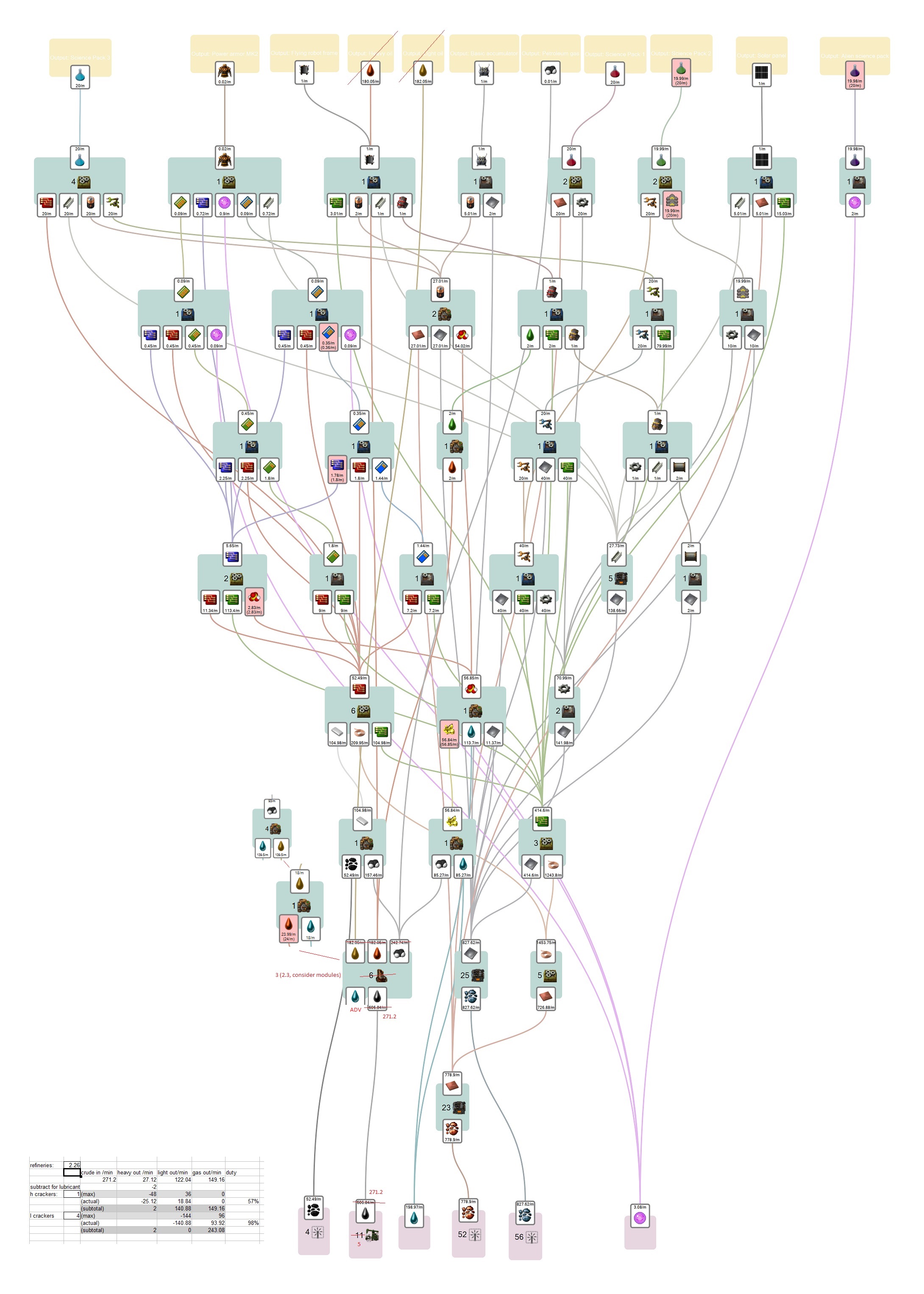Re: Productivity modules: where do you draw the line?
Posted: Sat May 07, 2016 3:42 pm
This is a chart I made using Foreman in preparation for an upcoming optimized base build:

My goal for this is 20 science of each type per minute, which should support 10 labs. In addition it will make upgrade modules at a modest rate for late game toys without crippling the science production.
In general my feeling about productivity modules are to start at the top and work down. So putting them in the labs has the most effect since an extra of each science saves a ton of resources. Next, blue science because that is effectively the same as producing more red circuits, smart inserters, batteries, and steel. Like, why would I use modules in just the inserters or the red circuits when most of them go to blue science where a module there gets better coverage?
T3 modules are expensive, so placing them I would want the highest bang for the buck. labs, I will have 10 of them. That's too many T3 modules to make, and not everything is for science. Red circuits, there's 6 assemblers. But green circuits? Only 3 assemblers and it's gobbling up 85% of the copper and 50% of the iron! I feel that the single biggest point of improvement is there. From there it gets more distributed, 1/4 of the circuits go to processors, 1/4 to red circuits, and most of the remaining to science. And 3/5 of red circuits also to science so safe to say the majority of everything still covered under the lab+blue science umbrella.
Iron is much more distributed, conserving this via production modules would take a lot. But the single biggest point of use again is green circuits, and if you trace where it's used it seems the same strategy applies.
While this would reduce resources needed to hit my goals dramatically, copper and iron are abundant. What I usually have trouble with is OIL. And most of it goes to plastic.. 64% of it anyway. The rest sulfur. These are only 2 buildings so easy to hit with modules. But naturally depending on how bad the oil situation is could potentially hit every building related to oil consumption. And again, nearly all of this goes to red circuits and batteries, which mostly goes to blue science.

My goal for this is 20 science of each type per minute, which should support 10 labs. In addition it will make upgrade modules at a modest rate for late game toys without crippling the science production.
In general my feeling about productivity modules are to start at the top and work down. So putting them in the labs has the most effect since an extra of each science saves a ton of resources. Next, blue science because that is effectively the same as producing more red circuits, smart inserters, batteries, and steel. Like, why would I use modules in just the inserters or the red circuits when most of them go to blue science where a module there gets better coverage?
T3 modules are expensive, so placing them I would want the highest bang for the buck. labs, I will have 10 of them. That's too many T3 modules to make, and not everything is for science. Red circuits, there's 6 assemblers. But green circuits? Only 3 assemblers and it's gobbling up 85% of the copper and 50% of the iron! I feel that the single biggest point of improvement is there. From there it gets more distributed, 1/4 of the circuits go to processors, 1/4 to red circuits, and most of the remaining to science. And 3/5 of red circuits also to science so safe to say the majority of everything still covered under the lab+blue science umbrella.
Iron is much more distributed, conserving this via production modules would take a lot. But the single biggest point of use again is green circuits, and if you trace where it's used it seems the same strategy applies.
While this would reduce resources needed to hit my goals dramatically, copper and iron are abundant. What I usually have trouble with is OIL. And most of it goes to plastic.. 64% of it anyway. The rest sulfur. These are only 2 buildings so easy to hit with modules. But naturally depending on how bad the oil situation is could potentially hit every building related to oil consumption. And again, nearly all of this goes to red circuits and batteries, which mostly goes to blue science.